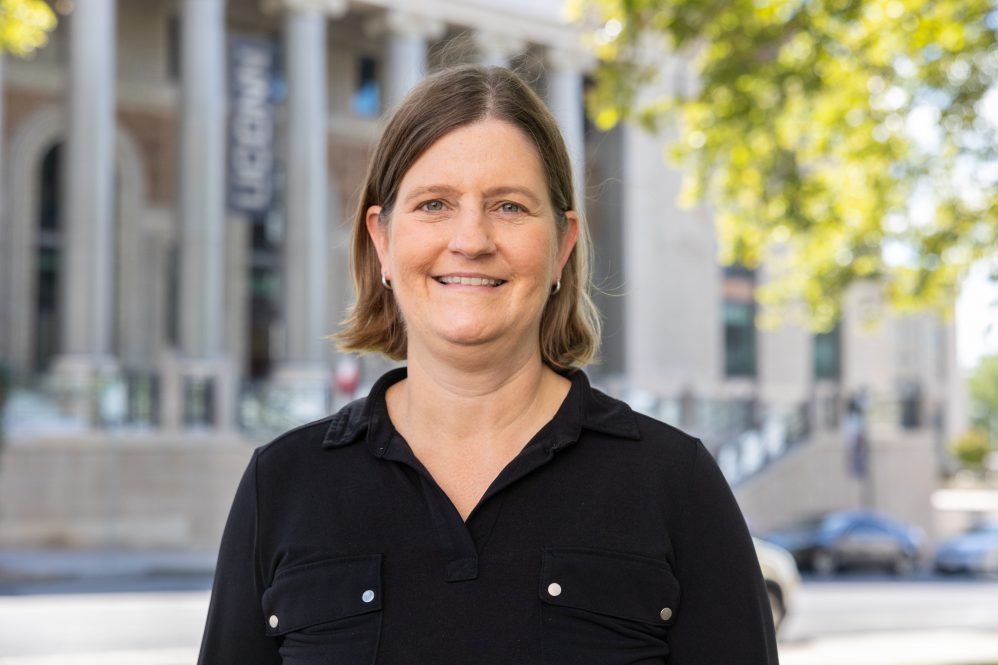The initiative began Sept. 30 and seeks to screen 7,000 youth ages 12 to 21 for substance use disorders. An expected 2,700 will be provided with services

UConn School of Social Work Associate Dean for Research Jennifer I. Manuel poses for a photo on the UConn Hartford campus on Sept. 1, 2022. (Sydney Herdle/UConn Photo)
Seven thousand Connecticut youth will be among those who benefit from a partnership between the UConn School of Social Work and the Child Health and Development Institute, as they and other agencies roll out an initiative to address substance abuse and mental health issues in young people around the state.
"Our youth, particularly underrepresented youth, are not getting high quality services, and when we don't reach them, they're at risk for their disorders or conditions to worsen over time," says Jennifer I. Manuel, the School's associate dean for research and an associate professor. "Substance use is highly correlated with ongoing mental health issues and being involved in the justice system. There are a host of reasons why we want to address this head on."
Manuel is the program evaluator for the Screening, Brief Intervention, and Referral to Treatment Prevention and Access to Treatment Hubs and Services initiative, known as SBIRT PATHS. She will spend the next five years working with the initiative's data to ensure its quality, overseeing analysis, and disseminating findings to the public.
The initiative, which began Sept. 30, is funded through the Substance Abuse and Mental Health Services Administration (SAMHSA) and seeks to screen 7,000 youth ages 12 to 21 for substance use disorders. An expected 2,700 will be provided with services, she says, some of whom also will receive help for other unmet social needs, including mental health and trauma-informed services.
Youth in Fairfield, Hartford, New Haven, New London, and Windham counties will work with four behavioral health providers that form regional SBIRT PATHS centers. More than 220 people from clinicians to care coordinators will receive training under the program.
"The idea is to increase access to services and make sure youth are getting the services they need to address their substance use concerns. Another goal, though, is to address mental health and trauma that intersect with substance use, so there's this kind of a wraparound approach to these services," Manuel says.
She adds, "Our service systems were largely fragmented when I was practicing, and that's still the case today. Providing access to integrated care is so important, and to do that early on when kids are just starting to use is critical to preventing long-term adverse consequences."
More than one in five, or about 20%, of youth from the targeted counties who receive behavioral health services each year say they actively use substances.
It's a longstanding problem that has only grown through the years, Manuel says, and the stigma around receiving services persists.
When Manuel worked in New York City, she says, she used a service model approach like what will be used in Connecticut and provided services and training at schools, community agencies, and housing authorities. Using a SAMHSA grant for that work, she also offered harm reduction resources, fentanyl testing, and Narcan training.
"Our goal was to build capacity in communities and with families in providing those resources," she says. "This work builds on that in Connecticut and in my research in substance use."

Manuel notes that the School of Social Work and the Child Health and Development Institute (CHDI) previously laid the groundwork for this initiative through some early collaborations. This new work allows that relationship to grow.
"This will have a real impact on youth and families, particularly those who are underrepresented, and that's exciting to me," she says. "Improving how we serve our communities and giving them greater access to services dovetails with my research on access to care and ensuring the delivery and quality of services is high. This will address gaps in our service system and that's one thing that's important to me."
Jack Lu '05 MSW, '16 Ph.D., SBIRT PATHS' principal investigator and CHDI director of implementation, says he's humbled to work alongside Manuel and CHDI's co-project director Christine Hauser.
"This partnership exemplifies practice and research innovations fostered in my public health social work career and training as a School of Social Work alum," Lu says. "With SAMHSA's support, our efforts will help ensure youth in Connecticut's most socially vulnerable counties have access to trusted behavioral health providers."
The grant's advisory committee comprises SBIRT PATHS center leadership; the Connecticut Department of Children and Families; Connecticut Department of Mental Health and Addiction Services; a motivational enhancement therapy/cognitive behavioral therapy national trainer; FAVOR, the state's organization for the National Federation of Families for Children's Mental Health; and CCAR, the state's organization for the National Alliance for Recovery Centered Organizations.
"There has been a longstanding relationship between CHDI and the University of Connecticut's School of Social Work to improve the lives of individuals and communities and advance social justice," School of Social Work Dean Laura Curran says. "We are excited to formalize this partnership and advance needed care for youth using substances in Connecticut through the SBIRT PATHS grant."






